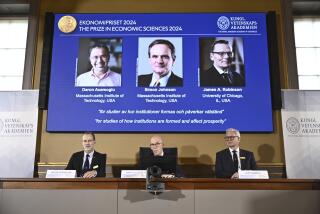Physics ‘error’ leads to Nobel Prize
- Share via
Adam Riess was sure he’d spotted a blatant error in his results. It was 1997, and the young post-doc’s measurements of distant, exploding stars implied that the universe was expanding at a faster and faster rate, instead of slowing down, as he had expected.
It wasn’t an error at all. Instead, what was at fault were some basic assumptions about the workings of the universe.
On Tuesday, the Johns Hopkins University astrophysicist received the Nobel Prize in physics for the revolutionary discovery and its implications, along with team leader Brian Schmidt of Australian National University and astrophysicist Saul Perlmutter of UC Berkeley and Lawrence Berkeley National Laboratory, who had reached the same conclusion independently.
At the time of their work, astrophysicists believed that the rate of expansion of the universe — set in motion by the Big Bang 13.7 billion years ago — would be slowing down as matter was pulled together by gravity. The goal at the time was to figure out how rapid the deceleration was.
What the two teams found instead was that the expansion of the universe was accelerating — an observation that could best be explained by the existence of a mysterious “dark energy” that pushes matter farther and farther apart.
Many scientists had thought that, just as the universe started with the Big Bang, it would end with a Big Crunch — with gravity pulling all the matter in the universe inward.
To measure the rate of deceleration, the two teams were tracking the movement of very bright exploding stars called Type 1a supernovae.
As the universe expands, the light waves we observe get stretched, and their hue shifts into the redder parts of the spectrum. The scientists looked at this “redshift” to see how far the supernovae (and thus, their surrounding galaxies) had traveled, and compared it to how dim — and thus how far away — they were.
Perplexingly, both teams’ measurements suggested that the supernovae were farther away than they should have been. They weren’t slowing down — they were speeding up.
The two teams proposed that the acceleration could be explained by the repulsive force of dark energy, which is now estimated to make up 73% of the universe. (Dark matter, which is unrelated to dark energy, makes up 23% of the universe, and all visible matter a mere 4%.)
“As far as fundamental significance for the foundations of physics and how we view the world, I think it’s absolutely one of the major discoveries of the 20th century,” said MIT theoretical physicist Frank Wilczek, one of the winners of the 2004 Nobel Prize for physics.
The work was, in a way, an affirmation of a proposal by Albert Einstein in 1917 for a “cosmological constant” — a sort of anti-gravity effect he used to make the general theory of relativity agree with the idea of a static universe.
When further observations showed the universe was not static, but expanding, Einstein threw the idea out of his equations, calling the constant the “biggest blunder” of his career.
Dark energy remains an unexplained force in physics — one that, if better understood, could potentially help reconcile inconsistencies between two of the field’s key theories, quantum mechanics and the general theory of relativity, Riess said. General relativity deals with the forces acting on objects on a large scale, while quantum physics deals with such interactions on a subatomic scale, but neither can fully explain both.
Riess said in a telephone interview Tuesday that he received the call from Stockholm in the wee hours as he was lying in bed awake listening to his 10-month-old son alternately crying and sleeping. He said he suspected who might be calling because of the early hour.
Perlmutter said he was roused not by a Nobel Prize Committee official but by the press.
“It’s interesting to wake up at 3 in the morning by someone saying they’re a reporter and they want to know how you feel,” he said during a news conference. “I felt fine, but I said, ‘Well, why do you ask?’”
Competition between the two teams was intense, said UC Berkeley astrophysicist Alex Filippenko, who worked with Perlmutter’s team before moving to Schmidt’s.
“The good thing is, both teams worked faster because both teams wanted to be first,” he said. “And the quality of the work improved, because both teams wanted to be best.”
Riess, who was working at UC Berkeley at the time, said that despite the rivalry the teams stayed in regular contact — including playing the occasional good-natured game of mud football.
The three scientists have earned other awards for the work; they also shared the 2006 Shaw Prize in Astronomy, nicknamed the “Nobel of the East.” Half of the $1.5-million awarded with the Nobel will go to Perlmutter; the other half will be shared by Riess and Schmidt.
But Perlmutter is the only one who will receive one of the most famous Nobel perks: UC Berkeley faculty members who receive Nobel prizes earn a coveted lifetime parking permit on campus.







